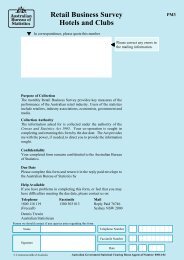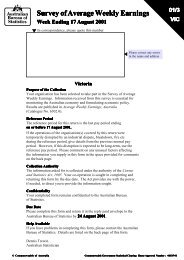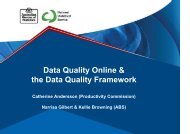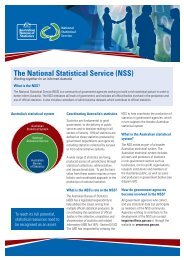SAE Manual Sections 1 to 4_1 (May 06).pdf - National Statistical ...
SAE Manual Sections 1 to 4_1 (May 06).pdf - National Statistical ...
SAE Manual Sections 1 to 4_1 (May 06).pdf - National Statistical ...
You also want an ePaper? Increase the reach of your titles
YUMPU automatically turns print PDFs into web optimized ePapers that Google loves.
A Guide <strong>to</strong> Small Area Estimation - Version 1.1 05/05/20<strong>06</strong><br />
Clearly, as indicated in questions 2 <strong>to</strong> 3 of Figure 4.2, the choice of any of these or other<br />
models depends on the following important interrelated fac<strong>to</strong>rs:<br />
i.<br />
ii.<br />
iii.<br />
iv.<br />
v.<br />
the level at which the small area estimates are required. Are small area estimates<br />
required at area-level or at some other sub-population such as age by sex group.<br />
the nature of the auxiliary data available related <strong>to</strong> the variable of interest. Again,<br />
these may include whether the data is at the unit-level (person-level), area-level or<br />
both.<br />
the nature of the variable of interest, i.e., whether it is continuous, binary or count<br />
data.<br />
users quality requirements for small area estimates<br />
access <strong>to</strong> statistical expertise<br />
Small area models can be fitted either at area-level or person-level. Area level models are<br />
fitted when the variable of interest and associated covariates in the auxiliary data are<br />
observed at the level of the specific geographic area, which is referred in Figure 4.1 as<br />
area-level analysis. On the other hand a unit/person-level analysis refers <strong>to</strong><br />
unit/person-level model that makes use of individual/unit level data in the analysis. When<br />
a model is fitted using unit/person-level data then the predictions based on this model<br />
must be aggregated <strong>to</strong> produce area-level estimates. It is also possible <strong>to</strong> fit a unit/person<br />
level model involving both individual and area-level covariates.<br />
Choosing the right model for the right type of data is crucial in the modelling process.<br />
For example, if the auxiliary information consists of data observed at area or unit level<br />
and the variable of interest is of a continuous nature, then it will be appropriate <strong>to</strong> use a<br />
linear model <strong>to</strong> estimate the variable of interest. Alternatively, if we have unit level data<br />
where the variable of interest is binary (e.g., 1= person has a disability and 0 = person<br />
has no disability) which is usually the case in many small area models, then we would go<br />
for a model that captures the binary nature of the observations, such as the logistic<br />
regression model. Similarly, if our data provides, say, area level count data of people<br />
with a disability then a suitable choice would be the Poisson model which is appropriate<br />
for count data models. It is also possible <strong>to</strong> use two or more models (e.g., unit-level and<br />
area-level models) provided that the dataset is amenable <strong>to</strong> such analyses . For instance,<br />
as we will see in the examples of Section 5 , the logistic and Poisson models are used <strong>to</strong><br />
predict person-level and area-level disability proportions, respectively.<br />
Australian Bureau of Statistics 30








